 Definition of Type 1 Errors & Type 2 Errors
Definition of Type 1 Errors & Type 2 Errors
Effects of Type I or Type II Errors on
Mold or Environmental Testing
- POST a QUESTION or COMMENT about how to report the density or level of mold or other particles found on indoor surfaces or in indoor dust samples
Definition & examples of Type 1 & Type 2 errors:
Classes of testing or statistical errors applied to mold or other environmental tests, inspections & reports can be divided into two basic mistakes or error types as we explain here. We include the definitions of type 1 and type 2 errors and we give examples of type 1 and 2 errors in building inspection and testing for mold contamination.
It is important to understand these types of environmental testing mistakes in order to reduce unnecessary risks to building occupants (failing to detect and report an environmental hazard) as well as to avoid wasting people's time and money focusing on on-problems (reporting as hazards conditions that are in fact not hazardous).
InspectAPedia tolerates no conflicts of interest. We have no relationship with advertisers, products, or services discussed at this website.
Definition & Practical Examples of Type I and Type II Errors in Building Environmental Testing for Mold or Other Contaminants

Types of Reporting Errors in Buildings: definitions of Type 1 Errors & Type 2 Errors
Using building environmental testing for mold contamination as an example this article describes the types of errors that may be made by thinking, technical, or procedural errors during an investigation or test.
Type One Errors - missing a problem that's present: Occasional occurrences of certain mold genera in samples might suggest a hidden or un-noticed mold problem in the building somewhere other than at the spot from which the sample was collected.
This is particularly true if the sample was collected by someone who is not expert at building science, indoor air quality, mycology, and related disciplines.
Examples of Type I errors during a mold investigation include:
- Focusing on "toxic black mold" and missing a dangerous reservoir of hard-to-spot light colored mold contamination
See LIGHT COLORED MOLD - Focusing on visible mold on building surfaces, defining a remediation plan based on visible mold, and failure to consider the possibility of significant problem mold reservoirs that are hidden in building insulation or building cavities
See HIDDEN MOLD in CEILINGS / WALLS - Errors in mold sample location selection: Where to stick adhesive tape for a surface sample, or where to place an air sampling device is of critical importance. If tests are performed in building areas remote from a large problem mold reservoir the tests may find little or no indication of a problem.
See DRYWALL MOLD TESTING
and ACCURACY OF AIR TESTS for MOLD - Errors or variations in the mold or other environmental test conditions: building conditions such as windows or doors open or shut, presence of people or animals in the building or not, fans on or off, heat or air conditioning on or off, and variations in indoor temperature and humidity all can make 1-4 orders of variation in the level of airborne particles in a building.
Type II Errors - asserting that a problem is present when it is not: Conversely, occasional occurrences of certain mold in samples might also seem to point a problem in a building where in fact none is present.

This is a greater risk where mold "counts" are used in air sampling than it it is when surface sampling is combined with visual inspection. Occupant indoor air or environment-related complaints or a building history of leaks can suggest that additional investigation is in order.
Examples of Type II errors during a building mold investigation include:
- Insisting that all "black mold" is "toxic black mold" when some is harmless.
See COSMETIC MOLD, RECOGNIZE - Allowing fear of mold to launch a costly investigation or cleanup project for trivial mold growth such as a few square inches of mold growth on bath tile grout.
See FEAR of MOLD - MYCOPHOBIA
See MOLD / ENVIRONMENTAL EXPERT, HIRE ? for help in determining when the risk indicators justify the cost and trouble of hiring a mold or environmental expert
To avoid both Type I and Type II errors in measuring toxic or allergenic mold exposure
the building consultant needs to understand mycology (e.g. what mold is likely to grow in buildings), the significance of the particles found (e.g. Pen/Asp spore chains vs. individual spores), the history, construction, and materials in the building and the details of the inspection itself when interpreting the importance of low levels of mold in building samples.
The articles recommended at the end of this page provide more examples of sources of Type 1 or Type 2 errors during building mold or environmental inspection, testing, lab sample analysis, & reporting.
Avoid This Building, Mechanical System Or Indoor Environment Troubleshooting Mistake
When making an observation, be sure that we are seeing what's really there, not what we want to see or what we failed to see, that is, seeing a pattern that isn't there or failing to see a pattern that is there.
In discussing studies of bird behavior, Joan E. Strassmann notes:
Snell-Rood and Cristol made sure to conduct this experiment blind, meaning that they did not know which birds had been held in captivity and which had not.
Not knowing which bird was in which group when taking down observations is important in just about any scientific study to avoid the danger of inadvertently seeing a pattern rather than seeing what is really there.
- Strassmann, Joan E., Slow Birding, the Art and Science of Enjoying the Birds in Your Own Backyard, TarcherPerigee (October 25, 2022) ISBN-10 : 0593329929 / ISBN-13 : 978-0593329924
...
Continue reading at MOLD TESTING & SAMPLING MISTAKES for more examples of how mold testing goes wrong, or select a topic from the closely-related articles below, or see the complete ARTICLE INDEX.
Or see these
Recommended Articles
- ACCEPTABLE MOLD LEVEL
- ACCURACY vs PRECISION of MEASUREMENTS
- ACCURACY OF AIR TESTS for MOLD
- AIRBORNE PARTICLE TEST SAMPLING CASSETTE STUDY
- AIRBORNE MOLD SPORE COUNT GUIDE - home
- AIRBORNE PARTICLE LEVELS vs IAQ - home
- AIRBORNE MOLD COUNT VALIDITY
- AIRBORNE MOLD SPORES CONCENTRATION BURSTS
- AIRBORNE PARTICLE ANALYSIS METHODS
- AIRBORNE PARTICLE & MOLD LEVELS in DUCTWORK
- AIR QUALITY on COMMERCIAL AIRCRAFT
- CULTURE PLATE MOLD TEST ERRORS
- DUST SAMPLE TYPES
- DUST SAMPLING PROCEDURE
- ENVIRONMENTAL TEST ERROR TYPES
- FALSE NEGATIVE MOLD TEST RESULTS
- MOLD TEST METHOD ACCURACY
- MOLD TEST vs. PROBLEM DIAGNOSIS
- MOLD TESTING & SAMPLING MISTAKES
- MOLD TESTING METHOD VALIDITY
- VALIDITY of MOLD TESTING METHODS
- VARIATION IN AIRBORNE PARTICLE LEVELS - CAUSES
- VARIATION IN AIRBORNE PARTICLE COUNTS vs SAMPLER HEIGHT
- VARIATION IN AIRBORNE PARTICLE LEVEL-COUNTS, EXTENT-OF
Suggested citation for this web page
ENVIRONMENTAL TEST ERROR TYPES at InspectApedia.com - online encyclopedia of building & environmental inspection, testing, diagnosis, repair, & problem prevention advice.
Or see this
INDEX to RELATED ARTICLES: ARTICLE INDEX to BUILDING ENVIRONMENT
Or use the SEARCH BOX found below to Ask a Question or Search InspectApedia
Ask a Question or Search InspectApedia
Questions & answers or comments about how to report the density or level of mold or other particles found on indoor surfaces or in indoor dust samples.
Try the search box just below, or if you prefer, post a question or comment in the Comments box below and we will respond promptly.
Search the InspectApedia website
Note: appearance of your Comment below may be delayed: if your comment contains an image, photograph, web link, or text that looks to the software as if it might be a web link, your posting will appear after it has been approved by a moderator. Apologies for the delay.
Only one image can be added per comment but you can post as many comments, and therefore images, as you like.
You will not receive a notification when a response to your question has been posted.
Please bookmark this page to make it easy for you to check back for our response.
Our Comment Box is provided by Countable Web Productions countable.ca
Citations & References
In addition to any citations in the article above, a full list is available on request.
- In addition to citations & references found in this article, see the research citations given at the end of the related articles found at our suggested
CONTINUE READING or RECOMMENDED ARTICLES.
- Carson, Dunlop & Associates Ltd., 120 Carlton Street Suite 407, Toronto ON M5A 4K2. Tel: (416) 964-9415 1-800-268-7070 Email: info@carsondunlop.com. Alan Carson is a past president of ASHI, the American Society of Home Inspectors.
Thanks to Alan Carson and Bob Dunlop, for permission for InspectAPedia to use text excerpts from The HOME REFERENCE BOOK - the Encyclopedia of Homes and to use illustrations from The ILLUSTRATED HOME .
Carson Dunlop Associates provides extensive home inspection education and report writing material. In gratitude we provide links to tsome Carson Dunlop Associates products and services.

